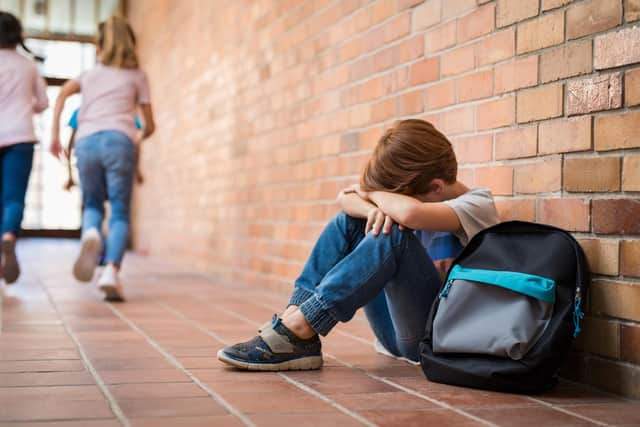Exclusive:Which Scottish schools had the highest rates of pupil suspension last year?
Pupils at a secondary school in South Lanarkshire were suspended for the equivalent of more than 400 days last year.
The statistics for Calderside Academy in Blantyre – recorded as 813 half days of temporary exclusion – were the highest in Scotland in 2022/23.
Advertisement
Hide AdAdvertisement
Hide AdThe school with the second highest number was Beath High in Fife, which had pupils suspended for 610 half days.


Meanwhile, Inverness High School recorded 547 half days, there were 486 such suspensions at Inverurie Academy, 470 at Gleniffer High School in Paisley, 458 at Larkhall Academy, 438 at Levenmouth Academy, and 428 at Lochside Academy in Aberdeen.
There were 376 at Fraserburgh Academy, and 363 at Inverness Royal Academy.
Carole McKenzie, executive director of education resources at South Lanarkshire Council, said: “Calderside Academy is a school at the heart of a very supportive community. Like all schools, it has its challenges, and we are aware of the relatively high number of exclusions.
"All exclusions are part of each school’s discipline procedures and are guided by the council’s Promoting Positive Relationships and Understanding Distressed Behaviour Policy. They are intended to be a short and temporary measure, with the time used constructively to resolve the situation and improve the outcome for the pupil and their family.
"We are working in partnership with the new head teacher to improve outcomes for all young people and this includes reducing the number of exclusions and addressing the reasons behind them.”
On the other end of the scale, a total of 25 secondary schools, and most primaries in Scotland, recorded no suspensions at all last year. There were zero in any school in the local authority area of Clackmannanshire.
Across Scotland, there were 11,675 cases of temporary exclusion of any length of time, with just one pupil being expelled, as previously revealed by The Scotsman.
Advertisement
Hide AdAdvertisement
Hide AdThe figures compare to 39,553 temporary exclusions and 164 permanent in 2007, when the SNP came to power.
Temporary exclusions are measured in both half days, which are known as “openings”, and in the number of cases. If a pupil was given a five day suspension, that would be one “case” and 10 openings.
Aberdeenshire had the highest number of cases of exclusion of any length of time last year, with 1,128, followed by Fife with 914, and South Lanarkshire with 831.
These cases of exclusion involved 691 pupils in Aberdeenshire, 650 in Fife and 562 in South Lanarkshire, with some being excluded more than once.
The use of exclusions has become a key debate in Scottish education in the wake of rising school violence, with some teaching unions calling for clearer guidance, saying schools have been pressured into limiting their use.
National figures published last week showed girls were involved in 3,248 cases of exclusion, while boys were in 8,428, with S2 and S3 being the years with the highest rates.
More than 37 per cent of exclusions were for one day, a further 33 per cent were for two days, and 18 per cent for three days.
A total of 70 per cent of the pupils involved were suspended one time, while at the other end of the spectrum there were five pupils suspended more than 10 times.
Advertisement
Hide AdAdvertisement
Hide AdPupils from poorer backgrounds were more likely to be excluded, as were those with additional support needs, particularly social, emotional and behavioural difficulties.
Physical assault without a weapon accounted for 29.5 per cent of cases, while 28.2 per cent were for verbal abuse of staff, and 25.6 per cent for general or persistent disobedience.
A total of 255 exclusions were linked to assaults with a weapon, a further 311 with an improvised weapon, while 375 involved drug use, 167 were for fire-raising, 133 for “malicious communications”, 28 for indecent exposure, and 17 for stalking. Refusal to attend class accounted for 856, or 7.3 per cent.
A Scottish Government spokesperson said: "Whilst Government can set out national parameters and guidance, use of exclusion is ultimately a matter for local authorities as the statutory responsibility for the delivery of education rests with them.
“That is why the Government is working with local authorities to bring forward a joint National Action Plan to set out the range of actions needed at both local and national level to improve behaviour in our schools.”
Scottish Conservative shadow education secretary, Liam Kerr MSP said: “Schools across Scotland are plagued with violence and pupils’ challenging behaviours. Teachers and students are suffering as a result.“The inconsistencies in different council areas around consequences – and in some cases ultimately exclusions – for pupils help nobody.“Teachers deserve clear and consistent guidelines surrounding measures and exclusions to properly tackle disruptive behaviour."The SNP continue to dither on all aspects of education but particularly around dealing with disruptive behaviour.“It’s long past time the SNP move on from their warm words and take meaningful action, including putting new guidelines in place.”
Efforts to cut exclusions began before the SNP came to power, with a scheme running from 1997, initially under the Scotland Office, seeking to reduce exclusions among pupils with social, emotional and behavioural difficulties.
Since 1998, guidance has emphasised that exclusion should only be used as a last resort, and between 1999 and 2003 there was a formal target to reduce exclusions.
Advertisement
Hide AdAdvertisement
Hide AdThe Labour-Liberal Democrat-run Scottish Executive later funded “restorative practice” pilots in North Lanarkshire, Highland and Fife which aimed to help disruptive pupils take responsibility for their actions and apologise.
An evaluation of the pilots found that enthusiastic implementation of restorative practices could improve behaviour in schools, and reduce exclusion rates. Education Secretary Jenny Gilruth has said she discussed exclusions policy at the first meeting of a new headteacher task force last June, but it is unclear whether national guidance will be strengthened or clarified.
Comments
Want to join the conversation? Please or to comment on this article.
